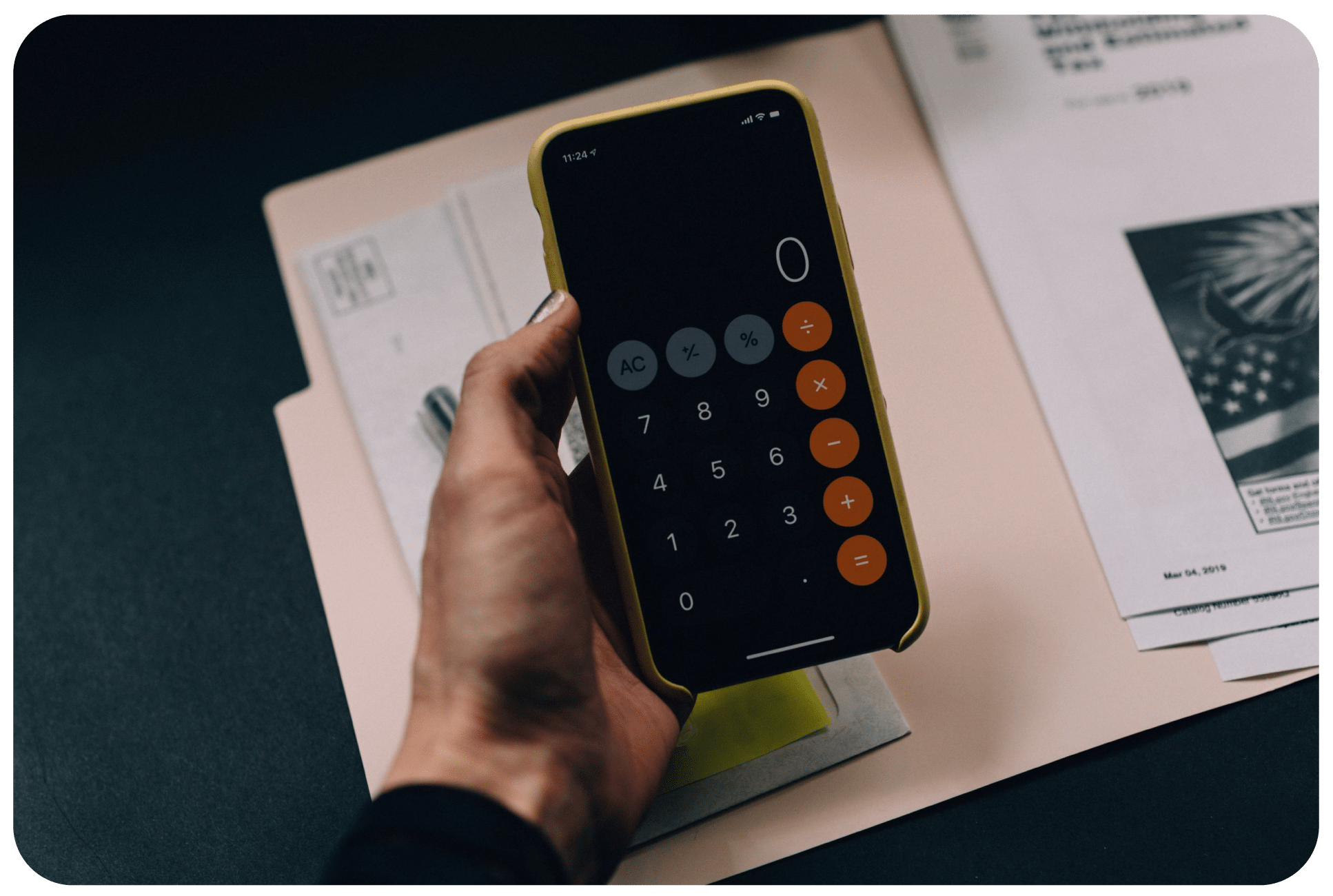How To Track the Budget of a Project?
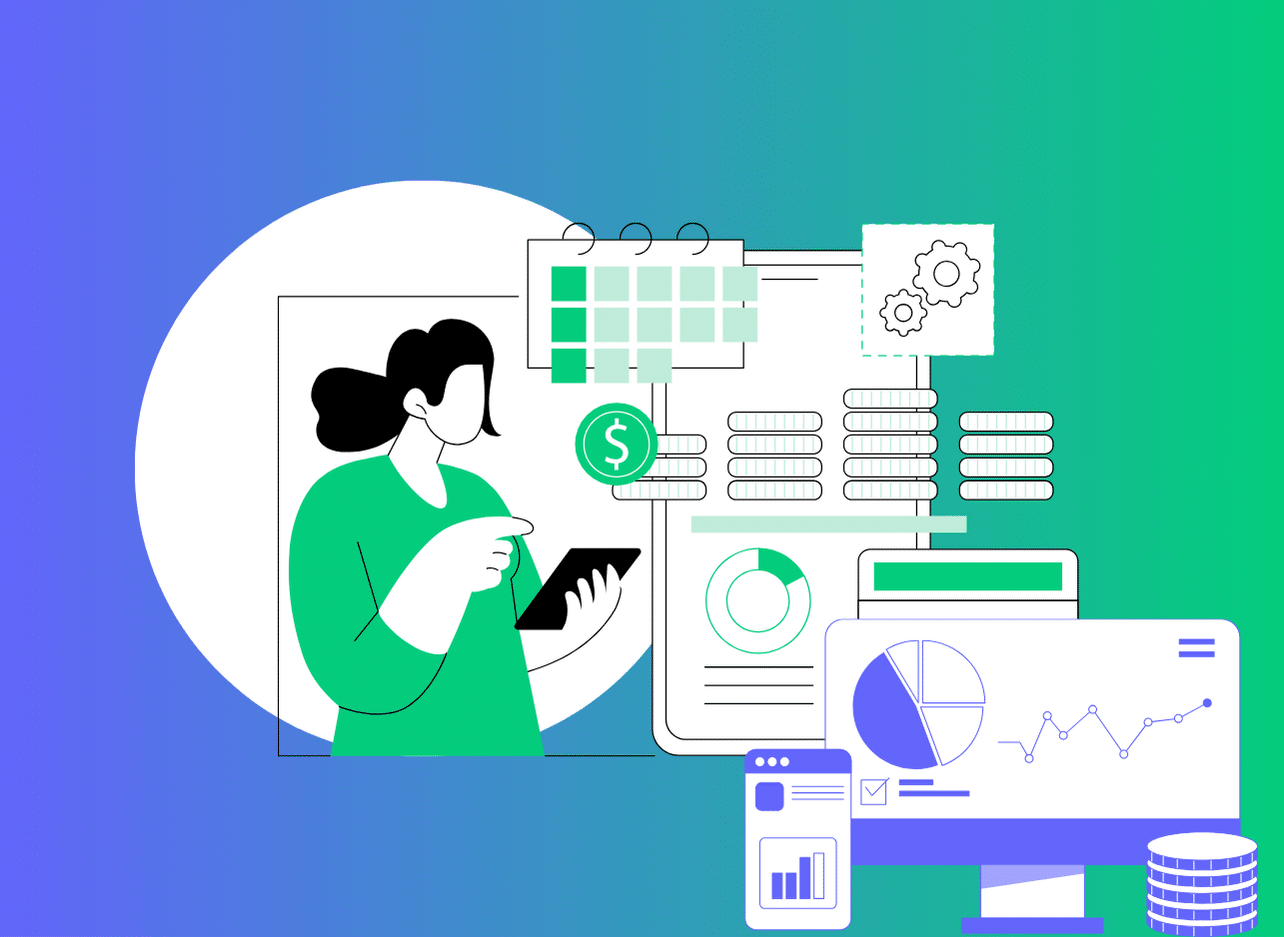
Ensuring cost control is strategic for any project. So, it becomes essential to implement a well-thought-out project budget monitoring in order to control expenses and anticipate variances to secure profitability.
Thus, budget management involves reliable and actionable data that budget monitoring tools can help collect and analyze. But then, where do you start and how do you track the budget of a project?
In this article, we offer you a guide to understand the challenges of budget monitoring and to deploy one, step by step, by asking yourself the essential questions.
What is Project Budget Monitoring?
Definition
Budget tracking in project management is the process of tracking how costs are used during the project. This involves comparing actual costs to projected costs to ensure that the project can be completed within the original budget . Carried out throughout the project, it is regularly updated.
Cost analysis and monitoring make it possible to detect any discrepancies. Project decision-makers must then adjust certain parameters to get the project back on track.
Finally, project budget control is essential to effective project management, in particular to support strategic decision-making:
- it allows visibility,
- promotes transparency,
- optimizes economic performance,
- helps make strategic decisions.
In addition, he contributes to optimal management of the funds by ensuring that they are available at strategic times.
What are the challenges of budget monitoring?
- Ensure that the defined budget is respected
Project budget monitoring analyses costs in detail in order to identify the expenses made and to come. He ensures the economic viability of the project by comparing the provisional budget and the current budget.
For IT Services For example, budget monitoring is strategic because it allows you to keep control over the time invoiced and the time actually invested. In addition, it is a reference for estimating the cost of the resources required, including margins, which guarantee profitability.
- Anticipate and correct
Budget monitoring helps to anticipate the risks of budget drifts, in the event of overruns or delays for example.
With the help of budget planning software such as Stafiz, you can set time objectives for each project phase. This allows you to quickly check that objectives have been achieved and to be alerted when a slippage is observed. In the event of a deviation, you can adjust the settings to limit overruns.
- Prioritize with global visibility
Budget monitoring can be implemented through tools such as the project monitoring table. This centralizes all the information, highlights the discrepancies and gives access to all the data that can then be used to make decisions.
The real-time view of costs helps to maximize financial performance, regardless of the billing method adopted, whether on a contract or a fixed price basis. Thus, the visibility obtained promotes transparency of information within the company, which is essential for management at the project portfolio level. This facilitates the management of the activity at the global level and helps to prioritize decisions.
Questions:
The project manager is generally responsible for budget monitoring, in conjunction with the management controller or the financial department. He ensures consistency between the planned budget and the actual progress, while alerting in the event of drift.
Step 1: Establish the Project's Costs
Estimating costs
To estimate the costs of a project, you need to understand what a project budget is made of:
- the various commercial proposals in the event of subcontracting,
- fees and purchases (licenses, software, etc.)
- a workload plan resulting from a rigorous allocation of resources,
- margins to deal with unforeseen events.
Once you have listed all the tasks that are critical to completing the project, you can incorporate them into your resource management strategy. You will then have to identify the number of resources needed, the cost of each and the duration of the intervention. This will allow you to calculate the overall cost of resources, taking into account the delays that may affect your calculation.
Define the provisional budget
Defining the provisional budget of a project is an essential step in budget monitoring, it will serve as a reference throughout the project.
In addition, you can use budget management software such as Stafiz, which has dedicated features such as obtaining a basis for comparison between the actual and the forecast, or the articulation of the different parameters of the project in order to achieve a specific margin or profit.
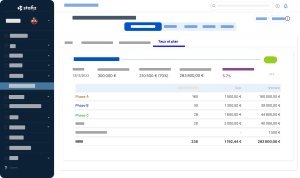
Creating a budget in Stafiz
So, you can create a budget in just a few clicks, taking into account all costs and revenues. This helps you assess the feasibility and profitability of the project initially.
Plan for risk management
Project costing must also take into account risk management, which consists of anticipating the risks of budget or deadline discrepancies. It involves defining proactive and corrective measures in order to understand and manage potential cost overruns.
Step 2: Continuously Monitor the Project's Budget
- Define a tracking method
Project budget monitoring can take different forms and frequencies depending on the company. It is essential to define them at the beginning of the project to ensure effective monitoring.
Choose a frequency adapted to your needs, the key is that it is regular to allow you to react quickly in the event of a deviation. In addition, we recommend that you define the process, content and form in advance in order to maintain consistency and avoid errors.
- Pick the KPIs
Choose relevant and adapted KPIs. Here is a list of 12 financial indicators to help you. Analysed in real time, they can alert on drifts to quickly make corrections.
- Identify and analyze gaps
To identify and analyze financial variances, compare the actual with the planned. Expenses must respect the provisional budget. Otherwise, you should seek to understand the causes of these discrepancies and measure their impact on the project's performance.
- Propose preventive and corrective measures
Deviations threaten the success of your project and should be avoided or corrected.
You must then think of strategies to return to a balance. Like what:
- reallocate resources : optimize the workload, swap junior/senior profiles, reduce the number of resources mobilized, optimize unbilled working time,
- reduce costs,
- renegotiate with the customer or service providers.
Track variances in real-time with budget reporting automation
To get a real-time view, a project management dashboard is strategic. Stafiz allows you to automate this reporting, freeing up your time for operations, which is essential in IT Services. However, the essential features will also depend on the billing method used.
- Choose a suitable tracking method based on billing method
With a fixed price, your problem is to monitor costs as a whole: internal and external talent, expenses, purchases, etc. The data must be at the most reliable in the field.
Stafiz can help you collect this data and carry out the tracking on landing. This can be recalculated on an ongoing basis when the resource planning is also integrated. The tool thus allows you to monitor progress, cost and margins precisely.
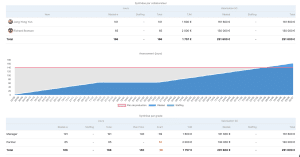
Tracking of all projected costs
Stafiz also has advanced reporting and alerting features. This way, you can quickly identify where deviations are coming from and when they will occur with
the BI decision-making tool that uses predictive and alerts you. You can perform analysis in different degrees: by person, BU, tasks, or phases.
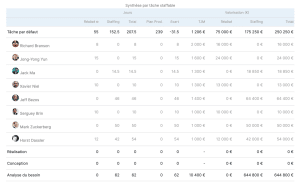
Predictive tracking of deviations by person, phases/tasks, over time
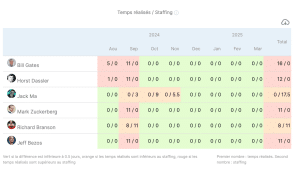
Tracking Deviations Over Time
In the sales department, the emphasis is mainly on the analysis of profitability. In the event of risks identified on a project, the profitability of the project can be threatened: unbilled days (discounts and gifts to customers) or costs can be essential and have an impact.
On Stafiz, it is possible to synchronize data such as resources, progress and cost tracking to analyze and understand the discrepancies between non-invoiced production and actual invoicing (to different degrees: by project or BU).
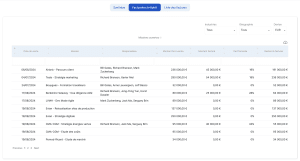
Tracking of non-invoiced production
Step 3: Using data to reorient project management
Once the data has been consolidated, these insights must be used to readjust management. One way would be, for example, to try to renegotiate certain points with the customer.
The utilization rate optimization also has a strategic role. You could adjust the allocation of resources by replacing the most expensive employees , most often the most experienced profiles, with more junior profiles.
This solution is interesting because these profiles cost you less. However, you need to make sure that the profiles you choose are able to perform the work with the same level of quality that was initially expected, otherwise customer satisfaction will be affected.
From a long-term perspective, you can also identify more profitable projects for the future.
5 Best Practices for Project Monitoring
Adopt a workload management logic
For service companies, monitoring budgets is important. However, it is actually the utilization rate that really impact profitability. The role of budget monitoring is not only to control costs, but also to make adjustments to maximize costs.
You can use different methods, one being to ensure that your talents are optimally occupied and on billable projects. Another involves verifying that all project activities have the appropriate resources in terms of quality and quantity and reallocating them if not.
Track budgets in a consolidated manner
In your budget monitoring, it is essential to consider several levels:
- at the project portfolio level,
- by BU,
- per customer.
By comparing all the projects, regardless of their sales method (fixed price or direct management), you will be able to identify and prioritize the most profitable projects, libraries, and regions.
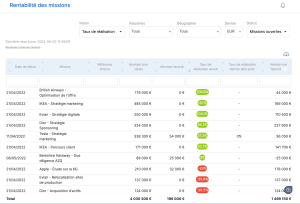
Project portfolio margin tracking
Integrate budget tracking with talent and skills management
Budget monitoring is part of a global strategy for allocating resources, which will maximize performance. By selecting the right employee, for the right mission, at the right time, you optimize the cost (salary, time spent) vs. profit ratio (quality, speed, impact of the work done).
Link project accounting with general ledger
Linking project accounting with general accounting allows you to obtain a macro view of the activity. Indeed, this method provides the necessary perspective on projects.
However, a vision from the perspective of metie-r, based on personalized analytical axes, is also relevant. With Stafiz, you can study which BUs, projects, geographies or customers are the most profitable over time. This then allows you to adapt the company's strategy based on these insights.
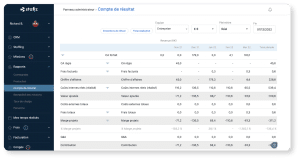
Income statement report in Stafiz
Use a comprehensive budget tracking tool based on your situation
- Facilitate collection, structuring and updating
Using a budget tracker helps simplify data collection, structuring, and updating. Indeed, software consolidates data from several sources, and helps you structure it. This gives you a healthy basis for making informed decisions based on reliable data.
However, it is essential to choose the right tool for the size and structure of your company, and the level of complexity expected.
- Define needs
One of the first questions to ask yourself is to define the scope of the tool: what uses do you need?
- Does your project management use different billing methods in parallel (flat-rate, time-and-age, subscription, mixed)?
- What granularity of the budget and its monitoring do you need? By phases and tasks?
- Do you need forward-looking management (on landing, with the rest to be done)?
- Do you have to consider all the costs, including pre-sales and subcontracting in particular?
- Do you need invoicing management integrated with budget monitoring?
- Do you need to easily export to your accounting software?
- Do you need to integrate pre-sales management, with quote generation and opportunity tracking?
- Analyze the current environment
Another issue to consider is the integration with your already installed tools.
- Are you already equipped with a CRM? In this case, connecting a budget tracking tool might be enough.
- Do you have an ERP? If it is business and operational oriented, it can meet your needs. However, a dedicated tool becomes essential when complexity increases (multi-projects, several billing methods).
- Do you use accounting software? If it integrates the logic of project management, it may be suitable.
This is also where the question of native integrations and APIs arises.
Some companies combine a CRM (for sales management), an accounting tool (for invoicing and payroll) and a tool dedicated to budget monitoring to ensure accurate and complete management of their projects. Here are several examples of possible combinations:
- CRM (Sales Force) + accounting tool (Sage) + dedicated tool (Stafiz).
- ERP (SAP) / dedicated tool (Stafiz) + accounting and payroll tool (Nibelis).
Good project cost monitoring does not stop at planning or steering during the mission. The budget close is equally essential because it brings together expenses and receipts, analyzes variance management, and draws relevant lessons for future projects.
With real-time project budget tracking software, this data is centralized, reliable, and ready for analysis. This provides you with accurate reporting and a holistic view that improves internal communication and, most importantly, helps maximize project profitability .
Questions:
Specialized project management and ERP software can automate budget monitoring.
They centralize planned, committed, and actual costs, and generate dashboards to anticipate variances.
Planned costs are the initial budget forecasts.
The costs incurred represent the contracted or ongoing expenses (orders, contracts).
Actual costs are the expenses actually paid and accounted for.

